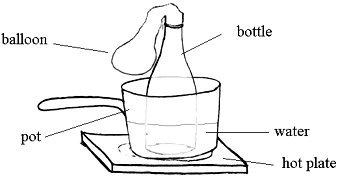Balloons
This task is about observing the changes that happen when a balloon is heated in water
| a) |
Your teacher will be demonstrating a science investigation.
Complete this worksheet for the activity.
|
|||||
|
||||||
|
b) |
Sam and Hiria were investigating what happens to the size of a blown-up balloon when it is put in hot and cold places.
|
|||||
| i) |
Will the balloon get bigger or smaller or stay the same size when it is put in a freezer?
bigger / smaller / stay the same size (Circle one)
|
|||||
| ii) |
Will the balloon get bigger or smaller or stay the same size when it is put in a warm place in the sun?
bigger / smaller / stay the same size (Circle one)
|
|||||



 ______
______